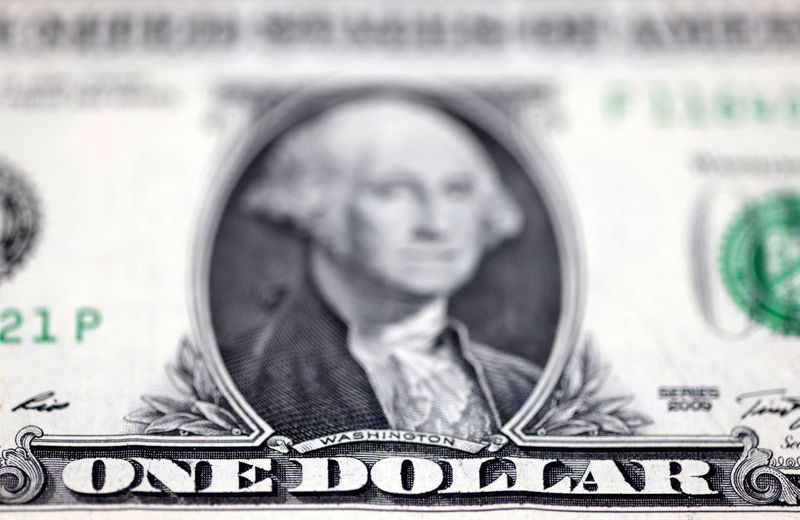Forex
Dollar dips on weak data, yen hurt by cautious BOJ


© Reuters. FILE PHOTO: U.S. Dollar banknote is seen in this illustration taken July 17, 2022. REUTERS/Dado Ruvic/Illustration/File Photo
By Karen Brettell
NEW YORK (Reuters) -The dollar fell against the euro on Friday on weaker than expected U.S. economic data but gained against the Japanese yen after Bank of Japan (BOJ) governor Kazuo Ueda said it was too soon to declare victory on inflation.
In cryptocurrencies, bitcoin held just below a more than two-year high reached on Wednesday.
U.S. manufacturing slumped further in February, with a measure of factory employment dropping to a seven-month low amid declining new orders. Construction spending, which had been expected to increase, also fell in January.
Economists at Goldman Sachs cut their gross domestic product (GDP) estimate for the first quarter by 0.2 percentage points to 2.2% after the data.
The dollar has been largely rangebound with traders focusing closely on economic data for any new clues on when the U.S. Federal Reserve is likely to begin cutting interest rates.
Marc Chandler, chief market strategist at Bannockburn Global Forex in New York, noted that “the U.S. is the key side of it,” in terms of driving currency moves. The greenback had looked like it was going to break higher in the past few days, but failed after Friday’s turn lower, he added.
The dollar was also pulled down in line with shorter-dated Treasury yields on Friday after Fed Governor Chris Waller said he would like the U.S. central bank to address a reset of the balance sheet towards shorter-term Treasury bills that would better match the short-term policy rate that the Fed controls as its key monetary policy tool.
The next major U.S. economic release will be February’s employment report due next Friday.
The fell 0.23% to 103.87. The euro gained 0.31% to $1.0837.
Data on Friday showed that euro zone inflation dipped last month but underlying price growth remained stubbornly high, adding to the case for the European Central Bank to hold interest rates at record highs a bit longer before starting to ease policy towards mid-year.
The euro zone’s currency has traded within a range of $1.07 to $1.11 since November as investors struggle to work out when the ECB and the Fed will start cutting rates.
“We are seeking out fresh news,” said Jane Foley, head of FX strategy at Rabobank, “whether that’s going to come from the ECB (European Central Bank) and a change in expectations, or further alteration of the market’s view about the ability of the Fed to cut even in June.”
JAPANESE INFLATION IN FOCUS The dollar rose against the yen after BOJ’s Ueda said it was too early to conclude that inflation was close to sustainably meeting the central bank’s 2% inflation target and stressed the need to scrutinize more data on the wage outlook.
That reversed a move from Thursday when BOJ board member Hajime Takata said that the central bank must consider overhauling its ultra-loose monetary policy, including an exit from negative interest rates and bond yield control.
Inflation expectations and the path of BOJ policy will likely depend on negotiations between large firms and unions over wage increases.
“If we’re right in expecting wage negotiations are going to lead to more signals that inflation is becoming a little bit more persistent in Japan, then we expect BOJ to exit negative interest rate policy,” said Bipan Rai, North American head of FX strategy at CIBC Capital in Toronto.
However, “I feel like it is priced in already”, Rai added. “Beyond there we’re really looking at what sort of tweaking they do to the yield curve control program.”
Big firms will settle negotiations on next year’s pay with unions on March 13, ahead of the BOJ policy meeting on March 18-19.
The dollar was last up 0.09% at 150.10 yen.
Sterling rose 0.26% to $1.2655.
Bank of England (BoE) chief economist Huw Pill said on Friday he thought the time for a first interest rate cut by the central bank since the coronavirus pandemic remained “some way off.”
was last up 1.4% at $62,320, after reaching $63,933 on Wednesday, which was the highest since Nov. 2021.

 Forex3 years ago
Forex3 years agoForex Today: the dollar is gaining strength amid gloomy sentiment at the start of the Fed’s week

 Forex3 years ago
Forex3 years agoUnbiased review of Pocket Option broker

 Forex3 years ago
Forex3 years agoDollar to pound sterling exchange rate today: Pound plummeted to its lowest since 1985

 Forex3 years ago
Forex3 years agoHow is the Australian dollar doing today?

 Cryptocurrency3 years ago
Cryptocurrency3 years agoWhat happened in the crypto market – current events today

 World3 years ago
World3 years agoWhy are modern video games an art form?

 Commodities3 years ago
Commodities3 years agoCopper continues to fall in price on expectations of lower demand in China

 Economy3 years ago
Economy3 years agoCrude oil tankers double in price due to EU anti-Russian sanctions





















